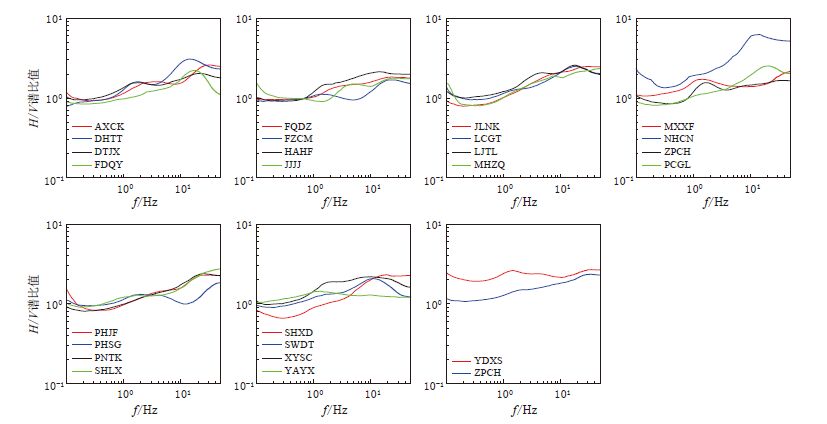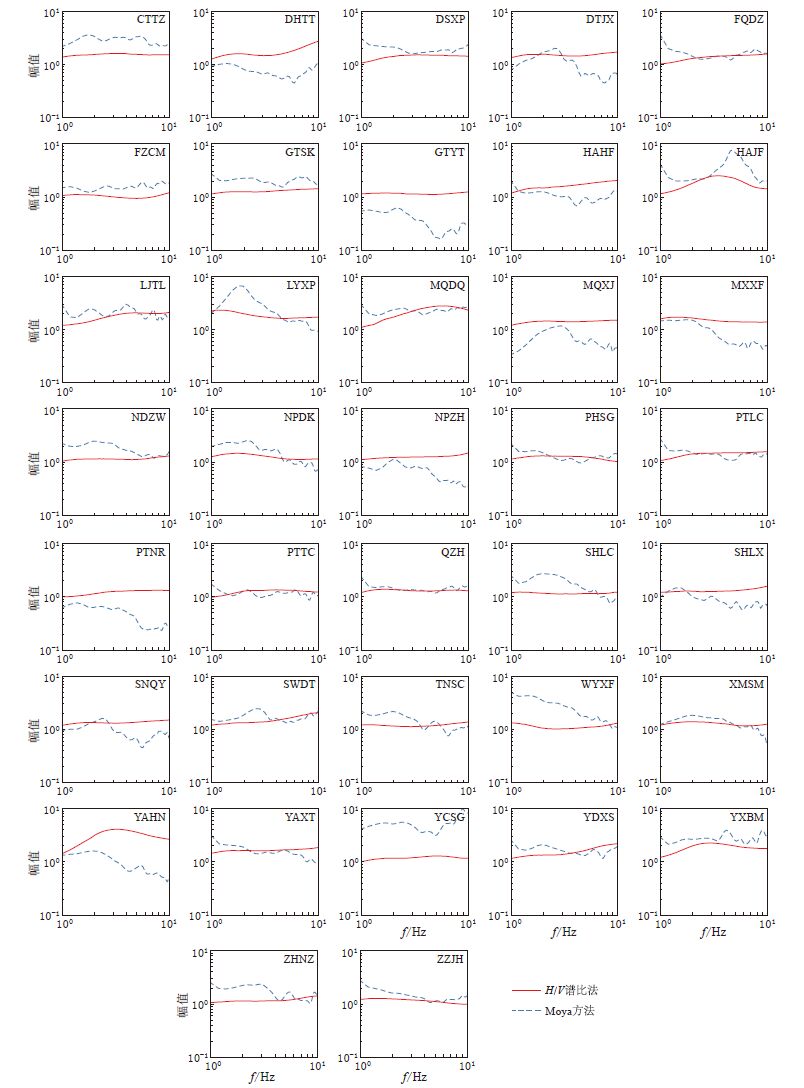Site response of Fujian seismic monitoring stations based on Nakamura H/V spectral ratio method
-
摘要: 应用噪声谱比法, 收集了福建台网观测台站记录的地脉动噪声数据, 计算分析了85个观测台站的场地响应. 根据场地响应曲线形态将福建台网观测台站分为4类, 并简要分析了影响台站场地响应结果的因素. 计算结果表明, 福建台网观测台站台基情况普遍较好, 在台站观测频带内场地响应曲线平坦, 大部分台站均没有明显的频率放大点. 本文采用H/V谱比法与Moya方法所获得的37个台站的场地响应结果基本一致, 仅有少数台站存在较大差异. 应用场地响应分析结果, 结合计算震级时所量取的周期, 对福建台网观测台站的单台震级校正值进行了估计, 并与统计方法获得的单台震级校正值进行了比对. 结果表明, 两种方法获得的台站震级校正值存在一定的相关性, 但由于考虑的影响因素不同, 具体的台站震级校正值尚存在差别.Abstract: Based on the Nakamura H/V spectral ratio (NHVR) method, the site response of 85 seismic monitoring stations in Fujian region were analyzed by using microtremors noise data recorded by the stations of Fujian teleseismic network in this paper. Then, we divided the stations into four groups according to the shape of site response curves, and briefly analyzed the factors resulting in different site response results. As a result of good site situation of platform, most of the stations of Fujian teleseismic network has a flat site response curve without obvious frequency amplification point. In addition, the site response obtained by NHVR method in this paper is basically consistent with that of 37 seismic stations calculated by Moya method, except for a few of stations. With reference to the periods during the magnitude calculation, we obtained the magnitude correction value of each seismic station of Fujian network, and compared them with those by statistical method. The results indicate that the two kinds of specific magnitude correction values have a certain correlation, but due to different factors considered during the analysis, there are also some differences.
-
引言
场地响应研究是一项基础性工作,其分析结果在很多方面都予以应用. 例如,估算中小地震的震源参数时,如果不能合理地对场地响应进行考虑,那么场地的低频放大作用将很容易使震源原来的拐角频率被掩盖,而拐角频率在数值上很小的变化都将显著影响应力降的估计结果. 因此,给出与频率有关的台站场地响应,将有助于提高利用数字地震记录估算中小地震震源参数的准确性. 研究结果表明(陈培善,秦嘉政,1983),由于台站台基场地响应的存在,震级计算结果也将随之变化,因此在进行震级偏差校正时,采取统计台站震级偏差平均值的方法存在一定的缺陷,还必须充分考虑到不同台站的台基场地响应情况. 此外,在地震危险性分析中,如果能够对场地响应情况进行合理考虑,其分析结果的可靠性和准确性都将得到改善. 综上所述,如果能够获得准确的场地响应分析结果,台网日常产出各种数据的可用性则将得到提升.
一般认为,固定台站均建在条件较好的基岩场地上,因此地表放大系数在所有考虑的频点上均为1,即基岩台站的观测记录是没有经过放大的. 但从近年来国内外的相关研究中(刘丽芳等,2007)可知,上述情况在场地条件很好的基岩台站上作为一种近似是可以的,然而大多数台站的场地响应曲线并不是完全平坦.
场地响应分析在理论上属于三维土层动力分析问题,因此,从理论上研究这一问题时,需要对台站所在场地的岩土工程资料有详尽的了解,随后再以此为基础建立较为准确的计算模型,然后应用地震波传播理论分析得出场地对地震动的反应. 显然,这种理论数值计算方法需要考虑土体的动力学特性、 土层分布情况、 输入地震动特性及边界条件等,这样才能保证所求反应量的准确性. 但由于场地介质的性质和分布情况极为复杂,且存在着一定的不确定性,因此理论分析方法还难以应用到实际工程分析中.
场地响应分析还可以采用经验法进行. 经验法即利用实际地震观测资料,甚至是地脉动噪声资料来分析场地地震反应. 该方法在场地响应分析中不需对场地土层特性进行详细了解,可以被广泛应用. 根据是否引入参考场地,经验法又分为参考场地法和非参考场地法. 参考场地法又称为传统谱比法(Borcherdt,1970),该方法通常选取建立在理想基岩上的台站作为参考台站,然后将所要研究的邻近台站与其进行比较. 理论上,理想基岩处的场地反应为常数,其不随频率变化,因此场地观测值之间的差异可以解释为所研究台站的局部场地响应. Andrews(1986)提出的线性反演法扩展了传统谱比法,即从地震记录中同时分离出震源、 传播路径和场地反应等. 线性反演法具有能够同时反演得到品质因子Q和场地地震响应的优势,因此成为目前应用最普遍的方法之一. 传统谱比法和线性反演法均为参考场地法,在应用这两种方法时都需要有一个合适的参考场地,但在实际应用中很难找到这样的理想参考场地,因此人们又提出了非参考场地法. Moya等(2000)提出了以某一地震事件为参考事件的分析方法,解决了参考场地法处理资料仅限于参考台站记录到的资料的局限性. 采用Moya方法时,需要对震源模型的有效性以及参考事件震源谱的低频段值和拐角频率的准确性进行检验. H/V谱比法也是最常用的非参考场地方法之一(Nakamura,1989). 该方法操作简单,且与其它方法获得的场地响应结果差异也较小. 根据所使用数据类型的不同,H/V谱比法又可细分为地震数据谱比法和噪声谱比法. 此外,为了提高场地响应估计结果的准确性,一些研究者将各种优化算法应用于场地响应分析中,如遗传算法(刘杰等,2003)等. 上述算法通常都是非参考场地法,避开了参考场地的选择,因此分析结果也更符合真实情况. 尽管上述场地响应计算方法不尽相同,但华卫等(2010)对这些方法的比较分析后认为,这些方法都能够获得较为一致的场地卓越频率,但对场地响应的反应结果却存在一定的差异.
由于H/V谱比法简便易操作,且结果可信度较高,因此诸多研究者都应用该方法进行了大量研究(郭明珠,宋泽清,2000; Arai,Tokimatsu, 2004,2005; Bragato et al,2007; 马淑芹等, 2007,2008; 朱荣欢,苏有锦,2007; 王伟君等,2009; 杨奎等,2012; Ducellier et al,2013; 张文辉等,2013). 本文采用噪声谱比法,利用福建地区地震观测台网产出的地脉动噪声记录,研究各台站的场地响应情况.
1. 福建地区地震观测台网及地脉动记录选取
经过20余年不断建设,目前福建地区共建成85个测震台站,84个强震台站,其中44个台址上同时配备了速度型地震仪和加速度型强震仪. 此外,福建地区还建成2个各配备16个短周期地震仪的观测台阵,分别位于福州地区和漳州地区(图 1). 在85个测震台站中,除14个台站使用FSS-3M型短周期地震仪外,其余各台站均使用宽频带地震仪. 所使用的宽频带地震仪类型有: 46个CMG-3ESPC-120地震仪,18个CMG-3ESPC-60地震仪,5个BBVS-60地震仪,1个FSS-3B地震仪和1个CTS-1地震仪. 各台站观测数据通过专用通信链路实时传输至福建省地震局,供进一步分析处理使用,并进行数据归档存储. 由于福建地区山地居多,因此各观测台站的台基状况普遍较好.
本文从2013年全年各月的归档波形数据中按照每个月挑选1天的方式,共挑选出12天的噪声记录. 为保证数据完整性和记录质量可靠性,挑选时主要参考了台站记录的连续率统计结果及人工波形记录质量的检查结果,并对其中存在明显异常的观测台站进行剔除. 与此同时,为分析不同噪声水平对计算结果的影响,分别截取每天00:00—04:00和11:00—13:00两个时段的地脉动噪声记录进行噪声谱比法对比分析. 通过挑选所获得的地脉动噪声记录可以认为是一个平稳的随机过程,能够较好地反映场地的动力特性.
2. 方法
本文所采用的H/V谱比法又称为中村(Nakamura)法. 其基本原理为: 设VS和HS分别为地表处垂直向和水平向的地震动振幅谱,VB和HB分别为基底处垂直向和水平向的地震动振幅谱,则经验传递函数可表示为

实验证实,基底处地震动的垂直分量与水平分量大致相等,即

实际观测记录也已证实,垂直分量经土层的放大效应后远小于水平分量. 换言之,可以假定垂直分量基本没有被放大,即VB≈VS,因此HB≈VB≈VS. 在此基础上,经验传递函数即可简化为Nakamura谱比,即

观测台站记录到的水平向地震动振幅谱与垂直向地震动振幅谱之比,即为各观测台站的场地响应.
按照如下步骤计算地震动噪声谱比:
1)记录段选取. 以10分钟为间隔,按照50%叠加率截取噪声记录. 福建台网中各台站采样率均为100 sps,因此所截取的记录段内共有6万个数据点,计算傅里叶幅值谱时的频率间隔约为0.003 Hz.
2)数据预处理. 为减小长周期段估计的偏差,需对波形数据进行去均值、 去长周期成分等处理. 同时,为减少有限长度数据序列进行快速傅里叶变换时所造成的频率渗漏,需将正弦或余弦窗函数应用于记录段数据序列中,使数据段两端平滑地衰减至零. 本文对每一段噪声记录在起始和末尾均加5%的余弦边窗.
3)傅里叶谱计算及平滑. 应用快速傅里叶变换法分别计算三分向傅里叶幅值谱V(f),uEW(f)和uNS(f),并采用Konno和Ohmachi(1998)提出的平滑函数对振幅谱进行平滑处理. 由平滑后的水平分量振幅谱计算合成水平向振幅谱,即

4)H/V谱比计算. 根据平滑后的水平向振幅谱H(f)和垂直向振幅谱V(f),即可计算得到该时段内的台站场地响应,即

再将所有时段内的场地响应结果进行平均即可得到各台站的场地响应结果.
3. 结果及分析
本文利用所收集到的福建台网地震动噪声记录,参照上述方法分别对各台站的场地响应进行计算. 首先分析不同噪声水平对计算结果的影响,然后根据计算结果将福建台网观测台站分为4类,并与Moya方法计算结果进行对比分析,最后将计算结果应用于单台震级校正中.
3.1 安静时段与吵闹时段计算结果对比
为了评估不同噪声水平时计算结果的稳定性,本文对安静时段(00:00—04:00)和吵闹时段(11:00—13:00)两种情况分别进行分析计算. 图 2和图 3分别给出了2013年12月27日福州城门台(FZCM)两个时段垂直向地震动噪声记录(任意截取10分钟)和傅里叶幅值谱及由谱比法计算的场地响应结果. 经对比可以看出,吵闹时段的高频地震动噪声水平明显高于安静时段,但应用谱比法计算的场地响应结果差别不大,二者基本一致. 因此本文将所有安静时段和吵闹时段的谱比法结果进行平均,以期获得各台站更加稳定可靠的场地响应结果. 图 4为根据全年地震动噪声记录获得的FZCM台场地响应. 图中灰色实线为FZCM台1—12月所有时段的平均场地响应结果,红色实线为最终的场地响应结果. 福建台网其余各台站的场地响应计算结果如图 5—8所示.
3.2 福建台网观测台站场地响应分类
依据各台站在所分析频段内(0.1—50 Hz)的场地响应曲线形态,将福建台网现有85个观测台站大致分为4类:
1)场地响应平坦,没有明显的频率放大点台站. 此类台站在福建台网中占多数,安溪参内台(AXCN)和安溪大坪台(AXDP)等47个台站均属于该类型. 此类台站的台基情况和观测环境等普遍较好,场地响应曲线平坦且没有明显的频率放大,因此能较好地记录该频段内的地震动(图 5).
2)中频段(1—10 Hz)场地响应分析结果中有明显的频率放大点台站. 福建台网中仅有少数台站符合该特征,如惠安净峰台(HAJF)、 龙岩西陂台(LYXP)、 闽清东桥台(MQDQ)、 南平东坑台(NPDK)、 永安槐南台(YAHN)、 尤溪阪面台(YXBM)、 漳浦六鳌台(ZPLA)和漳平象湖台(ZPXH)等8个台站. 从这些台站的场地响应曲线中能够明显观察到在中频段有较显著的频率放大点,因此对该频率及其附近的地震动成分将产生较明显的放大(图 6).
3)高频段(>10 Hz)场地响应分析结果中有明显的频率放大点台站. 福建台网中也有许多台站符合该特征,如安溪长坑台(AXCK)、 德化汤头台(DHTT)和大田均溪台(DTJX)等26个台站. 对于这类台站而言,在高频段地震动将受到较明显的场地放大作用(图 7).
4)场地响应平坦,在整个频段内都有较明显的频率放大点台站. 此类台站在福建台网中也较少,仅出现福鼎官路台(FDGL)、 武平湘店台(WPXD)、 厦门集美台(XMJM)和永定抚市台(YDFS)等4个台站中. 尽管这几个台站观测频带内的地震动值都会因此产生明显的放大,但放大的程度都不大,大多在2倍左右(图 8).
本文对上述4种类型台站的空间分布情况进行了分析,并未发现其具有明显的空间集聚特点. 以第4类台站为例,上述4个台站分别处于宁德福鼎、 龙岩武平、 厦门和龙岩永定等四地,可以认为上述场地响应分析结果并无集聚的区域性分布特点. 可见,福建台网台站的不同场地响应特征主要受台站所处位置的地形地貌条件、 台站台基条件和局部地质构造等因素的影响. 以LYXP台为例,由于该台修建于一个弱风化的溶洞之上,因此反映于场地响应分析结果中,即对中频段地震动会有较明显的放大. FDGL台、 WPXD台、 XMJM台和YDFS台等4个台站的台基虽然均为花岗岩,但均中等程度风化,因此这4个台站对不同地震动成分均有小幅的放大作用. 然而对其它台站的分析中发现,并非所有台站的场地响应特征均能归结于某一简单因素,说明影响场地响应的因素是多方面的,需要结合具体情况进一步详细分析讨论.
3.3 本文研究结果与Moya方法结果对比
如前文所述,Moya等(2000)方法在场地响应分析中也被广泛采用. 李祖宁等(2005)采用Moya方法,利用福建台网1998年以来的70次ML≥2.5地震的S波记录,对“九五”、 “十五”期间建设的37个台站的场地响应进行了分析研究,分析频带为1—10 Hz. 本文应用H/V谱比法得到的该37个台站的场地响应结果与Moya方法得到的结果进行了对比,结果如图 9所示. 可以看出,由于福建台网各台站的台基情况普遍较好,因此采用不同方法获得的场地响应结果差别不大. 尽管本文方法与Moya方法所获得的个别台站场地响应曲线在形状上存在着较大差别,但二者的场地响应值在数量级上十分接近. 对于大多数台站而言,两种方法计算得到的场地响应结果基本一致. 以惠安净峰台(HAJF)和龙岩西陂台(LYXP)为例,由于受观测台站台基的影响,两个台站对部分地震动成分都有较明显的放大作用,在两种方法所得出的场地响应结果中均有体现,但主要放大的频率成分及放大倍数则存在着一定的差异. 从具体的场地响应数值对比来看,本文获得的场地响应值基本都大于1,即各台站对该频带内的地震动都存在一定的放大; 而Moya方法获得的场地响应结果则较为跳跃,部分台站的场地响应值均在1之下,即该频段内的地震动成分是被抑制的,也有部分台站的场地放大响应非常显著,场地响应放大值甚至接近10.
从图 9的对比结果中还可以看出,两种方法在部分台站计算结果中存在着显著差异. 对于长汀汀州台(CTTZ)、 宁德樟湾台(NDZW)、 武夷新丰台(WYXF)、 永春石鼓台(YCSG)、 政和南庄台(ZHNZ)等5个台站,H/V谱比法计算得到的场地响应值小于Moya方法的结果; 而对于德化汤头台(DHTT)、 古田玉田台(GTYT)、 闽清雄江台(MQXJ)、 明溪雪峰台(MXXF)、 南平樟湖台(NPZH)、 莆田南日台(PTNR)、 永安槐南台(YAHN)等7个台站,H/V谱比法计算得到的场地响应值则大于Moya方法的结果.
华卫等(2010)利用2003年云南大姚MS6.2地震序列对比分析了Moya方法、 H/V谱比法和参考场地法等3种场地响应分析方法,认为Moya方法与H/V谱比法所得到的场地响应分析结果在形态上较为相似,但由于两种方法的原理不尽相同,结果也存在一些差异. 另一方面,李祖宁等(2005)研究认为,由于Moya方法所选用的事件数目有限,部分台站射线覆盖也较为稀疏,因此不能较全面地反映场地响应的真实情况,这也是两者间存在差异的原因之一. 更重要的是,由于H/V谱比法是基于“垂直向不放大”这一基本假设推导得出的,其本质上还是一种参考场地法. 近年来一系列研究(郭明珠等,2004)也已充分证实,垂直分量还是具有一定的场地效应,因此本文研究结果可作为绝对场地响应结果的一种近似.
3.4 场地响应结果在单台震级校正中的应用
由于场地响应的存在,使得由单台记录测量地震震级是不够准确的. 如果在测量震级时将场地影响扣除,单台震级计算结果与最终事件震级结果间的离散程度将减小,根据单台记录测量的地震震级则将可用于地震预警等具有高度时间要求的应用中.
对于地方近震,地震台网通常会测量ML震级. ML震级是基于W-A地震仪所定义的一个震级标度,其所对应的周期在1.0 s左右,但在实际操作中所量取的周期往往小于该数值. 图 10给出了福建台网FZCM台848次地震事件中ML震级测量过程中所量取的周期分布统计图. 可以看出,所量取的周期远小于1.0 s,平均值为0.21 s,中值为0.19 s,方差为0.18 s. 其它各台站均存在类似情况,这里不再赘述. 因此,本文根据场地响应分析结果,结合各台站实际量取的周期,分别计算得到了各台站单台震级校正值,结果列于表 1. 郭阳(2014)采用统计法,分析历史地震事件中单台震级与事件震级的偏差,同样得到福建台网各台站震级校正值,也列于表 1.
表 1 本文方法与郭阳(2014)得到的福建地震观测台网各台站震级校正值的对比Table 1. Comparison of magnitude adjusted values of the stations of Fujian seismic monitoring network derived by this paper with those by Guo(2014)台站名称 震级校正值 台站名称 震级校正值 台站名称 震级校正值 本文 郭阳(2014) 本文 郭阳(2014) 本文 郭阳(2014) AXCK -0.18 0.03 LYXP -0.26 -0.19 SXJX -0.10 0.21 AXCN -0.17 -0.05 MHZQ -0.27 0.05 TNSC -0.06 0.14 AXDP -0.16 0.10 MQDQ -0.44 -0.08 WPPC -0.08 0.23 CTCX -0.14 -0.04 MQXJ -0.15 0.10 WPXD -0.43 0.02 CTTZ -0.21 0.02 MXXF -0.16 -0.02 WYXF -0.01 -0.06 DHTT -0.38 0.01 NDZW -0.05 -0.01 XMJM -0.39 0.02 DHTZ -0.09 0.05 NHCN -0.51 0.01 XMSM -0.11 0.06 DSXP -0.16 -0.10 NJJS -0.22 -0.20 XPSS -0.03 -0.10 DTJX -0.18 0.11 NPDK -0.09 0.11 XYSC -0.34 0.08 FACY -0.04 -0.15 NPZH -0.11 0.15 XYXY -0.16 -0.08 FDGL -0.30 -0.30 PCGL -0.07 0.10 YAHN -0.53 -0.59 FDQY -0.11 -0.07 PCNP -0.12 0.05 YAXT -0.23 -0.04 FQDZ -0.18 0.11 PHJF -0.17 -0.02 YAYX -0.12 -0.06 FZCM 0.02 -0.14 PHSG -0.08 0.10 YCSG -0.10 0.14 FZLQ -0.08 0.15 PNTK -0.17 0.06 YDFS -0.38 0.01 FZRX -0.18 -0.11 PTDT -0.16 -0.11 YDXS -0.32 -0.04 GTSK -0.14 0.03 PTLC -0.18 -0.08 YTGL -0.15 0.14 GTYT -0.05 0.23 PTMZ -0.21 0.06 YTGY -0.17 0.18 GZLF -0.07 -0.25 PTNR -0.11 0.15 YXBM -0.25 -0.11 HAHF -0.29 0.14 PTTC -0.12 0.07 YXHT -0.14 0.01 HAJF -0.36 -0.26 QGQH -0.04 -0.12 ZAQD -0.28 0.08 JJJJ -0.16 -0.08 QZH -0.12 0.05 ZHNZ -0.07 0.12 JLNK -0.29 -0.21 SCLX -0.11 -0.11 ZPCH -0.22 -0.08 JNSX -0.13 -0.06 SHLC -0.05 0.02 ZPGN -0.19 0.02 JOJA -0.13 0.14 SHLX -0.11 0.14 ZPLA -0.37 -0.10 LCGT -0.22 0.13 SHXD -0.22 0.07 ZPXH -0.15 0.28 LCJX -0.16 0.09 SNQY -0.13 -0.04 ZZJH -0.03 0.04 LJTL -0.31 -0.16 SWDT -0.27 -0.06 LYJJ -0.15 -0.16 SXFK -0.15 0.05 对比表 1中两个震级校正值可以看出,由于采用不同的方法计算震级校正值,且主要考虑的影响因素也不同,二者在具体的数值上存在一定差异. 郭阳(2014)在统计过程中考虑了传播路径、 震群分区和量规函数等因素的影响,但对于个别统计样本较少的台站,统计结果的准确性还值得进一步讨论; 而本文仅考虑了场地响应的影响,所得到震级校正值大都为负值,表明各台站对地震动成分均存在一定程度的放大. 但从方便操作的角度来看,本文方法具有明显优势. 此外,在统计单台震级偏差时,扣除场地响应的影响也是非常必要的.
以LYXP台为例,图 11分别给出了校正前单台震级与平均震级的偏差及采用本文震级校正值校正后的偏差分布. 可以看出: 校正前的单台震级明显偏高,其与平均震级偏差平均约(0.40±0.24)个震级单位; 经校正后,单台震级与平均震级的偏差程度明显减小,二者间偏差为(0.08±0.22)个震级单位. 综上,应用场地响应分析结果能够在一定程度上减小由于场地影响所造成的单台震级离散,从而提高单台震级结果的准确性.
4. 结论
本文利用福建台网观测台站的地脉动噪声记录,应用H/V谱比法研究了台站场地响应. 结果表明,H/V谱比法具有操作简便、 结果可靠等特点,因此具有较好的可推广性. 通过本文研究,得出以下结论:
1)福建台网观测台站的场地响应特征主要是由台站所处位置地形地貌、 台站台基及局部地质构造等多种因素综合影响的结果.
2)通过H/V噪声谱比法与Moya方法得到的场地响应结果的对比分析表明,不同方法获得的场地响应结果存在较好的一致性,因此本文结果具有一定可信度.
3)由于H/V谱比法是基于“垂直向不放大”这一基本假设推导得出的,可能与实际情况不完全相符,因此计算得出的场地响应实际上还是一种相对场地响应. 相关研究(卢滔等,2006)也已充分表明,H/V谱比法得到的场地响应分析结果可作为真实场地响应结果的一种近似.
4)场地响应分析结果可用于单台震级校正研究. 根据场地响应结果计算得出的单台震级校正值能够在一定程度上减小单台震级与平均震级的偏差,提高单台震级准确性.
5)本文对影响台站场地响应结果的因素了解还不够全面,分析也不够深入. 尽管文中列举了几个看似能归结为某一因素的台站,但分析还是十分局限的,这也是在以后工作中需继续深化的部分. 作者将继续收集福建台网的历史地震事件记录,应用地震事件谱比法分析各台站场地响应,并与本文结果进行比对,最终给出准确可靠的台站场地响应分析结果.
-
表 1 本文方法与郭阳(2014)得到的福建地震观测台网各台站震级校正值的对比
Table 1 Comparison of magnitude adjusted values of the stations of Fujian seismic monitoring network derived by this paper with those by Guo(2014)
台站名称 震级校正值 台站名称 震级校正值 台站名称 震级校正值 本文 郭阳(2014) 本文 郭阳(2014) 本文 郭阳(2014) AXCK -0.18 0.03 LYXP -0.26 -0.19 SXJX -0.10 0.21 AXCN -0.17 -0.05 MHZQ -0.27 0.05 TNSC -0.06 0.14 AXDP -0.16 0.10 MQDQ -0.44 -0.08 WPPC -0.08 0.23 CTCX -0.14 -0.04 MQXJ -0.15 0.10 WPXD -0.43 0.02 CTTZ -0.21 0.02 MXXF -0.16 -0.02 WYXF -0.01 -0.06 DHTT -0.38 0.01 NDZW -0.05 -0.01 XMJM -0.39 0.02 DHTZ -0.09 0.05 NHCN -0.51 0.01 XMSM -0.11 0.06 DSXP -0.16 -0.10 NJJS -0.22 -0.20 XPSS -0.03 -0.10 DTJX -0.18 0.11 NPDK -0.09 0.11 XYSC -0.34 0.08 FACY -0.04 -0.15 NPZH -0.11 0.15 XYXY -0.16 -0.08 FDGL -0.30 -0.30 PCGL -0.07 0.10 YAHN -0.53 -0.59 FDQY -0.11 -0.07 PCNP -0.12 0.05 YAXT -0.23 -0.04 FQDZ -0.18 0.11 PHJF -0.17 -0.02 YAYX -0.12 -0.06 FZCM 0.02 -0.14 PHSG -0.08 0.10 YCSG -0.10 0.14 FZLQ -0.08 0.15 PNTK -0.17 0.06 YDFS -0.38 0.01 FZRX -0.18 -0.11 PTDT -0.16 -0.11 YDXS -0.32 -0.04 GTSK -0.14 0.03 PTLC -0.18 -0.08 YTGL -0.15 0.14 GTYT -0.05 0.23 PTMZ -0.21 0.06 YTGY -0.17 0.18 GZLF -0.07 -0.25 PTNR -0.11 0.15 YXBM -0.25 -0.11 HAHF -0.29 0.14 PTTC -0.12 0.07 YXHT -0.14 0.01 HAJF -0.36 -0.26 QGQH -0.04 -0.12 ZAQD -0.28 0.08 JJJJ -0.16 -0.08 QZH -0.12 0.05 ZHNZ -0.07 0.12 JLNK -0.29 -0.21 SCLX -0.11 -0.11 ZPCH -0.22 -0.08 JNSX -0.13 -0.06 SHLC -0.05 0.02 ZPGN -0.19 0.02 JOJA -0.13 0.14 SHLX -0.11 0.14 ZPLA -0.37 -0.10 LCGT -0.22 0.13 SHXD -0.22 0.07 ZPXH -0.15 0.28 LCJX -0.16 0.09 SNQY -0.13 -0.04 ZZJH -0.03 0.04 LJTL -0.31 -0.16 SWDT -0.27 -0.06 LYJJ -0.15 -0.16 SXFK -0.15 0.05 -
郭阳. 2014. 福建数字地震台网近震震级偏差的研究[D]. 福州: 福州大学土木工程学院: 15-39. Guo Y. 2014. The Research on Local Magnitude Deviation at Digital Seismic Network of Fujian Province[D]. Fuzhou: Civil Engineering School of Fuzhou University: 15-39 (in Chinese).
Andrews D J. 1986. Objective determination of source parameters and similarity of earthquakes of different size[C]//Earthquakes Source Mechanics. Washington D C: AGU: 259-267.





 下载:
下载:










